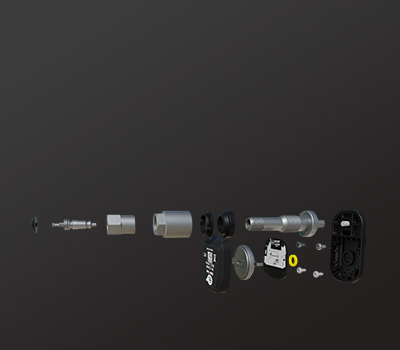How TPMS Improves Fuel Efficiency and Extends Tire Life

Introduction:
In the ever-evolving landscape of vehicle technology, fuel efficiency and tire longevity have emerged as essential considerations for drivers and fleet managers alike. With fuel prices remaining unpredictable and environmental concerns at the forefront, optimizing vehicle performance has become a necessity rather than a luxury. One of the most effective yet often overlooked innovations contributing to these goals is the Tire Pressure Monitoring System (TPMS).
A TPMS is designed to alert drivers when tire pressure falls below a certain threshold, helping them maintain optimal tire inflation at all times. While this may seem like a minor feature, its impact on fuel efficiency and tire life is profound. According to studies by the U.S. Department of Energy, underinflated tires can reduce gas mileage by up to 3%, while also significantly accelerating tire wear. Over time, this not only leads to more frequent tire replacements but also contributes to higher fuel consumption and increased emissions.
Moreover, consistent tire pressure helps maintain proper traction and handling, directly influencing vehicle safety. The National Highway Traffic Safety Administration (NHTSA) estimates that a properly functioning TPMS can prevent thousands of accidents annually by reducing tire-related issues.
In this blog, we will explore how TPMS improves fuel efficiency, enhances tire longevity, and ultimately saves money for drivers. Whether you’re managing a commercial fleet or simply want to ensure your family vehicle runs smoothly, understanding the benefits of TPMS can lead to smarter, more economical driving habits.
Understanding TPMS: What It Is and How It Works
A Tire Pressure Monitoring System (TPMS) is an electronic system that monitors the air pressure inside pneumatic tires on vehicles. It comes in two main types: direct TPMS and indirect TPMS.
- Direct TPMS uses sensors mounted inside each tire to transmit real-time pressure readings to the vehicle’s onboard computer.
- Indirect TPMS estimates pressure by analyzing data from the anti-lock braking system (ABS) and wheel speed sensors.
Both systems aim to alert the driver when tire pressure drops 25% or more below the manufacturer’s recommended level. Some advanced TPMS models even provide exact pressure values, offering real-time insights into each tire’s status.
This proactive approach ensures that drivers are informed the moment their tires deviate from optimal pressure, allowing them to act quickly to correct the issue before it affects performance or safety.
TPMS Fuel Efficiency: Reducing Unnecessary Fuel Burn
Maintaining proper tire pressure is crucial for maximizing fuel economy. Underinflated tires have a larger contact area with the road, which increases rolling resistance — the force resisting the tire’s motion. This extra resistance requires more energy to overcome, forcing the engine to work harder and burn more fuel.
A TPMS eliminates the guesswork from tire maintenance by providing timely alerts, thereby reducing periods of underinflation. Here’s how it contributes to fuel efficiency:
- Lower Rolling Resistance: When tires are properly inflated, they roll more easily, reducing engine strain and fuel consumption.
- Better Vehicle Balance: Balanced tire pressure improves alignment and stability, which contributes to smoother rides and efficient fuel use.
- Avoiding Overcompensation: Without TPMS, drivers may unknowingly operate on low pressure, leading them to compensate by accelerating more — further reducing fuel efficiency.
Studies have shown that maintaining proper tire pressure through TPMS fuel efficiency benefits can improve mileage by 1% to 3%, which translates into significant savings over time, especially for high-mileage vehicles or commercial fleets.
Enhancing Tire Longevity: Preventing Premature Wear and Tear
Tires are one of the most expensive maintenance items for any vehicle, especially for commercial users. Tire longevity is directly tied to maintaining optimal air pressure, and a TPMS plays a pivotal role in ensuring that tires wear evenly and predictably.
Here’s how TPMS contributes to extended tire life:
- Even Tread Wear: Incorrect tire pressure causes uneven wear — overinflation leads to center tread wear, while underinflation causes shoulder wear. TPMS ensures pressure remains balanced.
- Reduced Heat Buildup: Underinflated tires flex more and heat up quickly, which can lead to blowouts and sidewall damage. Proper inflation maintained through TPMS mitigates this risk.
- Decreased Tread Separation Risk: Excessively worn or damaged tires are more prone to tread separation, especially during high-speed driving. By maintaining ideal pressure, TPMS reduces this likelihood.
The cost of replacing tires prematurely can add up quickly. With TPMS improving tire longevity, drivers can maximize the lifespan of their tires, ensuring optimal performance and safety throughout their usage cycle.
TPMS and Vehicle Safety: More Than Just Maintenance
While TPMS fuel efficiency and tire longevity are major benefits, the safety advantages should not be underestimated. Tire pressure affects braking distance, steering responsiveness, and overall road grip — all critical to accident prevention.
Some key safety benefits of TPMS include:
- Early Detection of Leaks: A slow puncture might go unnoticed without a TPMS, eventually leading to a flat or blowout. With TPMS, drivers can act promptly.
- Stability on the Road: Properly inflated tires maintain better traction, especially in adverse weather conditions, reducing the risk of hydroplaning or skidding.
- Improved Handling and Braking: Well-inflated tires respond better to sudden maneuvers or emergency stops, potentially preventing collisions.
These safety factors not only protect the driver and passengers but also reduce insurance claims, downtime, and liability in commercial settings.
Environmental Impact: TPMS Supports Sustainability Goals
As environmental sustainability becomes an increasing concern across industries, TPMS stands out as a tool that aligns with green initiatives. By optimizing tire pressure, it indirectly contributes to reducing greenhouse gas emissions and conserving resources.
- Lower Emissions: Improved fuel efficiency means fewer emissions per mile traveled.
- Fewer Tire Replacements: Extending tire life reduces demand for raw materials and energy used in manufacturing new tires.
- Waste Reduction: Longer-lasting tires mean fewer discarded in landfills.
For companies focused on environmental responsibility, investing in a TPMS can be a simple yet impactful way to improve their carbon footprint while also enhancing operational efficiency.
Economic Benefits for Individuals and Fleets
Whether you’re a private car owner or managing a commercial fleet, the financial benefits of TPMS are significant:
- Reduced Fuel Costs: Even a 1% improvement in fuel efficiency can save hundreds of dollars annually for a high-mileage driver.
- Lower Maintenance Expenses: Fewer tire-related breakdowns and longer intervals between replacements lower operational costs.
- Increased Vehicle Uptime: For fleets, avoiding tire failures translates into less downtime and more revenue-generating time on the road.
Over time, the savings generated by TPMS fuel efficiency and tire longevity far outweigh the initial investment in the system.
Conclusion: Why TPMS Is a Must-Have for Modern Drivers
The modern road demands smarter driving solutions, and the Tire Pressure Monitoring System (TPMS) is one such innovation that delivers both immediate and long-term benefits. From improving fuel efficiency and enhancing tire longevity to boosting safety and supporting environmental goals, TPMS proves to be far more than just a dashboard light — it’s a guardian of both performance and economy.
Investing in TPMS is not merely a matter of compliance or convenience. It’s a strategic choice that can lead to measurable savings, better vehicle health, and peace of mind for drivers and fleet operators alike. By keeping tires properly inflated at all times, TPMS helps ensure every trip is safer, smoother, and more cost-effective.
In a time where every drop of fuel and every mile of tire life counts, a Tire Pressure Monitoring System stands as a small upgrade with a massive impact.
Ready to Maximize Fuel Efficiency and Extend Tire Life? Contact Minder Research Today
If you’re serious about saving fuel, extending the life of your tires, and enhancing your vehicle’s safety and performance, it’s time to invest in trusted TPMS technology. Minder Research, Inc. is a leading name in tire pressure monitoring solutions, offering innovative products designed to keep you informed, efficient, and safe on every drive.
Whether you’re an individual driver or a commercial fleet manager, Minder Research has the tools and expertise to help you reduce costs and drive smarter.


